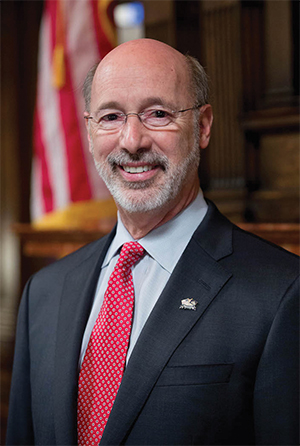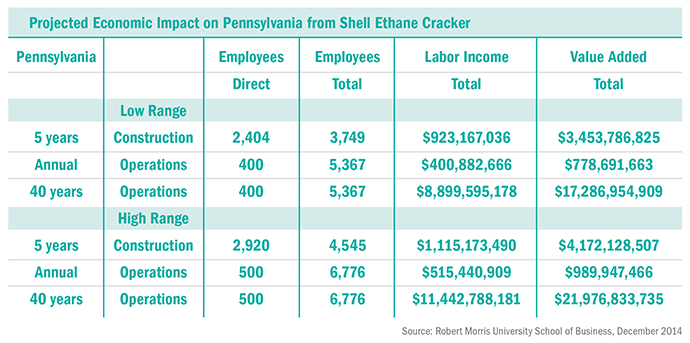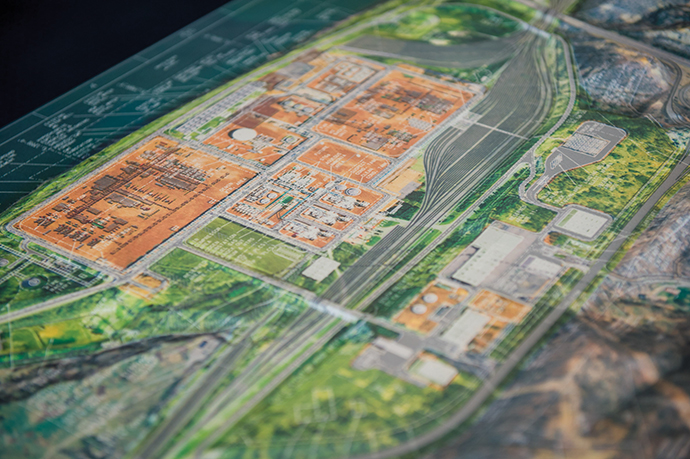The borough of Monaca in Beaver County, Pennsylvania, has a rich manufacturing history. During the borough’s early days, manufacturers produced porcelain ware, glass, tile, tubing, drawn steel and wire. Today, Monaca’s history of making things is about to expand.
In 2011, Shell officials announced that they were looking for a location for a potential petrochemical plant. Three states were in the running: West Virginia, Ohio and Pennsylvania. In March 2012, Shell selected a site in Pennsylvania for consideration, mostly due to transportation and logistics. Four years later, on Tuesday, June 7, 2016, Shell Chemical Appalachia took the final steps toward building a petrochemical plant, otherwise known as an ethane cracker, which will produce ethylene and polyethylene to make plastics used in products that we use every day.
“Over the past four years, the Commonwealth of Pennsylvania worked with Shell to finalize plans to construct this facility,” says Pennsylvania Governor Tom Wolf. Several key players throughout the state have propelled the project, including Secretary of Community and Economic Development Dennis Davin, the Governor’s Action Team, the Pittsburgh Regional Alliance, and local officials in Southwestern Pennsylvania. “Shell’s decision to invest in Southwestern Pennsylvania is a testament to the Commonwealth’s dedication to ensuring we have a government that works.”

The project involves a $1.65-billion tax credit, the largest in Pennsylvania history. But when I spoke with Michael Marr, external relations advisor, Shell Pennsylvania Chemicals, he didn’t list incentives as a key consideration for the decision.
“The real driver was the time commitment of state leaders to pass legislation for companies that meet certain job creation thresholds,” says Marr. “They quickly passed the legislation within months, and that really was the key driver for Shell.”
Another key driver was location. Monaca is the ideal location because more than 70 percent of North American polyethylene customers are within a 700-mile (1,126-km.) radius of Pittsburgh. “There are two geographic drivers for the project — it’s close to the ethane natural gas supply and the North American customer base,” says Marr. “We had steadfast support for our efforts across two administrations, and strong bipartisan support, as well as great coordination and strong support with community leaders, particularly the Pittsburgh Regional Alliance.”
It will take 6,000 construction workers to build the plant, which will bring nearly 600 jobs to the region once it’s operational. Reports have shown that the projected economic impact will be around $6 billion. “With this magnitude of investment by Shell, we also expect that the region will continue to develop into a Northeast petrochemical hub due to the local, reliable, and inexpensive natural gas byproducts made available by Marcellus Shale production,” says Gov. Wolf.

The processes taking place at this world-scale polyethylene plant work like this: The plant will have one ethane cracking unit that takes natural gas brought into the region by pipeline and breaks those molecules down into ethane molecules. The molecules are then sent to three other units to make polyethylene pellets that will be sold into the marketplace. The ethane cracker will produce 1.6 million metric tons of polyethylene a year.
“Polyethylene is an important component of plastics and is a major building block for expanding Pennsylvania’s plastics industry,” says Wolf. “With the Pittsburgh region being home to more than 100 plastics-related companies that employ more than 5,000 people, this facility will serve as the centerpiece in the region for the creation of new markets for polyethylene.”
Governor Wolf also hopes that there will be the added potential of attracting additional manufacturing investments that will lead to even more business attraction and job creation.
The plant will be one of the largest of its kind in North America, the largest single industrial investment in the Pittsburgh region in a generation, and the first of its kind outside of the Gulf Coast. Shell, government and many community leaders are excited about the economic impact that the plant will undoubtedly have on the region. However, there are those who are concerned with how it will impact air quality.

According to Professor Illah Nourbakhsh, director of Carnegie Mellon University’s Community Robotics, Education, and Technology Empowerment (CREATE) Lab, during the process of making ethylene, two types of chemicals are emitted that are linked to heart disease, cancer, low birth rate and other health issues. These chemicals — volatile organic compounds (VOCs) and nitrogen oxides (NOx) — both pollute the air. Shell’s cracker plants in Louisiana and Texas give off several thousand tons of NOx each year, but according to Shell the plant in Monaca will be designed to have the lowest achievable emission rates for VOCs and NOx.
Though many are aware of the potential for pollution, no one can deny that the plant will be a major economic driver for the region that will attract plastics manufacturers and lead to more job growth. Main construction for the cracker is expected to begin in December 2017, and production should start within the next decade.

